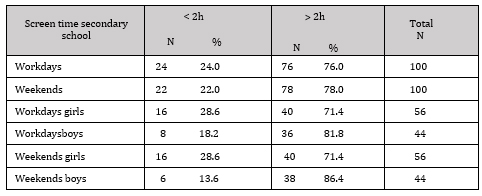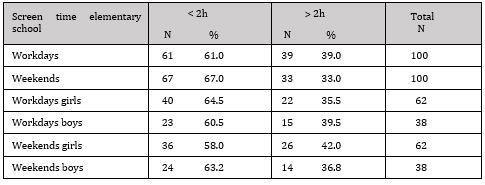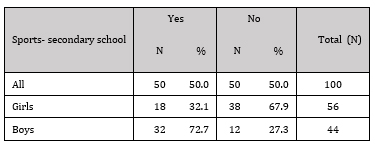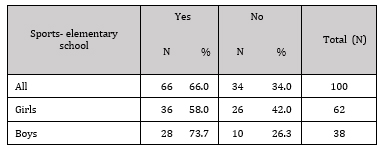| |
|
|
INTRODUCTION
Independent of physical activity levels, sedentary habits are
associated with increased risk of cardio-metabolic disease,
all-cause mortality, and a variety of physiological and
psychological problems [1]. The issue of screen time for children
being online, while still debated, is out-of-date. This is because
there is no clear agreement on when the time spent on digital
technology goes from moderate to excessive; ‘how much is too much’
is highly individual, depends on the child’s age, individual
characteristics and broader life context [2]. The American Academy
of Pediatrics has recommended no more than two hours of screen time
for children and teenagers for extracurricular activities [3]. But
children and youth spend more than 7 h per day using media; the vast
majority of them have access to television in the bedroom, access to
a computer, the Internet, a video-game console, and a cell phone
[4]. There is evidence that higher levels of screen time are
associated with various negative effects on the health of children
and youth, with the evidence for adiposity, unhealthy diet,
depressive symptoms and quality of life being the strongest [5].
Recent evidence raises concerns about media's effects on aggression,
sexual behavior, substance use, disordered eating, and academic
difficulties [3]. In order to improve cardiorespiratory and muscular
fitness, bone health, and cardiovascular and metabolic health
biomarkers of children, those aged 5–17 should accumulate at least
60 minutes of moderate- to vigorous-intensity physical activity
daily [6]. One of the voluntary global targets for prevention and
control of non-infectious diseases to be attained by 2025 is 10%
relative reduction in prevalence of insufficient physical activity
[7].
The aim of our study was to compare screen time and participation in
sports activities between two groups of adolescents in Inđija.
METHODS
Study design and setting: A cross-sectional study was conducted
in Primary Healthcare Center “Dr Milorad Mika Pavlovic”, Inđija in
the period September 2018-September 2019. Inđija is a town and a
municipality located in the Srem District of the autonomous province
of Vojvodina, Serbia. Per 2011 census, the town has the total
population of 26,025, while the municipality has 47,433 inhabitants
[8]. Primary HealthcCare Centers’ Pediatric Department had
approximately 6870 medical records of children aged 1-18 in the
study period.
Data collection and variables. Participation in the study was
voluntary. 200 students participated, of which 100 fifth grade
elementary school students and 100 first grade secondary school
students. Data were collected by means of a questionnaire, which was
designed for this study. Participants filled the questionnaire when
they were at the pediatrician examination. Fifth grade children
(younger than fifteen) were with their parents who had given their
consent for participation. First grade secondary school children
consented to participate in the study. Daily screen time for
extracurricular activities longer than 2 hours was considered
ignoring the recommendations. Students who went in for
extracurricular sport trainings for more than six months before the
study started were considered sports participants.
Statistical methods. The results are presented by the method of
descriptive statistics and the differences between the groups were
calculated by chi-square test. P-value of <0.05 was considered
significant.
RESULTS
Out of all 200 participants, 118 (59%) were girls, and 82 (41%)
were boys. In the elementary school students group 56% were girls,
and in the secondary school students group 62% were girls. There
were not significant gender differences between these two
groups.Mean age in the group of elementary school students was
10,64, and in the group of secondary school students 14.76.
115 (57.5%) of all children on workdays and 111 (55.5%) at weekends
ignored the recommendations for screen time. Daily screen time among
secondary school and elementary school students is presented in
Table 1 and Table 2. Gender differences and differences between
screen time on workdays and at weekends in both groups individually
did not reach statistical significance. Secondary school students
spent significantly more time in front of screens (˃ 2h daily) for
extracurricular activities both on workdays (χ²=28.06, p<0.01), and
at weekends (χ²=40.996, p<0.01) than elementary school students.
Secondary school girls spent more time in front of screens than
elementary school girls both on workdays (χ²=15.246, p<0.01), and at
weekends (χ²=10.384, p<0.01). Secondary school boys spent more time
in front of screens than elementary school boys both on workdays
(χ²=15.5, p<0.01), and at weekends (χ²=21.5, p<0.01)
Table 1. Screentime daily – secondary school
students

Table 2. Screentime daily - elementary school students

Out of all participants, 84 (42%), 50 (50%) of secondary school
students and 34 (34%) of elementary school students did not
participate in extracurricular sports activities (Table 3 and Table
4). Secondary school boys participated in extracurricular sports
considerably more than secondary school girls (χ²=16.234, p<0.01).
Gender differences for extracurricular sports participation between
elementary school students did not reach statistical significance.
Elementary school students participated significantly more in
extracurricular sports than secondary school students (χ²=5.225,
p<0.05). Elementary school girls participated in extracurricular
sports considerably more than secondary school girls (χ²=7.966,
p<0.05). There was no significant difference in sports participation
between boys.
Table 3. Extracurricular sports participation -
secondary school students

Table 4. Extracurricular sports participation -
elementary school students

DISCUSSION
Computer use, video games and ownership of devices, such as
tablets and smart phones, occurs at an increasingly young age.
Screen time, television viewing, in particular, has been negatively
associated with the development of physical and cognitive abilities,
and positively associated with obesity, sleeping problems,
depression and anxiety [9]. Recent research by the Institute of
Public Health of Serbia shows that 57.8% of students in the 5th, 7th
grade of elementary school and the 1st grade of secondary school
spend more than two hours a day watching television on weekdays.
There is a significantly higher percentage of boys of the same age,
who play games for more than two hours a day during workdays and at
weekends [10]. In our study no significant gender differences were
present in both groups individually, 5th grade of elementary school
and the 1st grade of secondary school children, across screen time
per day. But secondary school students ignored the recommendations
for daily screen time significantly more than elementary school
students, gender differences between elementary and secondary school
students did reach statistical significance.
Physical activity and body mass index are strongly linked from
childhood to adulthood, the relationship between these gets
increasingly higher with age and therefore it is important to
establish healthy habits early to prevent obesity in later life.
Studies have shown that physical activity, sports and participation
in sports competitions decline during adolescence, especially in
girls [11]. While physical activity levels decline drastically
during adolescence, levels of screen time increase considerably
[12]. Our research shows that in our two groups elementary school
students participate in extracurricular sports activities
significantly more than secondary school students, with a
significant decline in secondary school girls.
Promoting physical activity and a healthy diet might prove a better
strategy than merely reducing screen time to decrease harmful
effects of screen time on the health of children and youth. Some
studies have shown that parental rules regarding screen time and
participation in physical activity play a role in the amount of
screen time among children and adolescents, concluding that programs
that encourage limit-setting by parents and promote physical
activity may reduce screen time among youth [13]. Screen time was
also associated with poor attachment to parents and peers in
adolescents [14]. Therefore, anticipatory guidance for healthy
behavioral changes should be focused on the family. Parents should
recognize and understand their own roles in modeling appropriate
media use and balance between media time and other activities [15].
To maximize health benefits, approaches to resolve the inactivity
crisis should attempt to both increase deliberate physical activity
and decrease sedentary behaviours, especially in the pediatric
population [16].
There were several limitations that need to be considered in
interpreting these results. We collected our data by means of a
questionnare which was designed for this study, but our results were
easy to interpret and to compare with other studies. We also have a
moderate sample of this two uniform groups of students.At first, the
strenght of our study could be considered through the research work
in primary healthcare. The method of this study could be the basis
for larger studies with more participants included.
CONCLUSIONS
This research showed that more than half of the students in
Inđija ignored the recommendations for screen time on workdays and
at weekends, secondary school students considerably more than
elementary school students. Approximately forty percents of the
pupils did not participate in extracurricular sports. Elementary
school students participate significantly more than secondary school
students, with significant decline in secondary school girls. In the
future some public programs should be focused on students of these
two groups (5th - 8th grade of elementary school) to prevent decline
in sports activities among high school students resulting in screen
time increase.
Conflict of interest: None declared.
REFERENCES
- Katzmarzyk PT, Church TS, Craig CL, Bouchard C. Sitting time
and mortality from all causes, cardiovascular disease, and
cancer. Med Sci Sports Exerc. 2009; 41(5): 998-1005.
doi:10.1249/MSS.0b013e3181930355
- UNICEF. The State of the world's children 2017. Children in
a Digital World. 2017.
- Strasburger VC, Hogan MJ, Mulligan DA, Ameenuddin N,
Christakis DA, Cross C, et al. Children, adolescents, and the
media. Pediatrics. 2013; 132(5): 958–61.
- Strasburger VC, Jordan AB, Donnerstein E. Health effects of
media on children and adolescents. Pediatrics. 2010; 125(4):
756-767. doi:10.1542/peds.2009-2563
- 5. Stiglic N, Viner RM. Effects of screentime on the health
and well-being of children and adolescents: a systematic review
of reviews. BMJ Open. 2019;9(1):e023191.
doi:10.1136/bmjopen-2018-023191)
- WHO. Global Strategy on Diet, Physical Activity and Health
[Cited 2020. June 7th]. Available from:
https://www.who.int/dietphysicalactivity/factsheet_young_people/en/
- World Health Organization. Global Status Report on
Noncommunicable Diseases. WHO. 2014. [cited 2020/06/07];
Available from:
http://www.who.int/nmh/publications/ncdstatus-report-2014/en/
- 2011 Census of Population, Households and Dwellings in the
Republic of Serbia: Comparative Overview of the Number of
Population in 1948, 1953, 1961, 1971, 1981, 1991, 2002 and 2011,
Data by settlements. Statistical Office of Republic Of Serbia,
Belgrade.2014. Available from:
http://pod2.stat.gov.rs/ObjavljenePublikacije/Popis2011/Knjiga20.pdf
- Domingues-Montanari S. Clinical and psychological effects of
excessive screen time on children. J Paediatr Child Health.
2017; 53(4): 333-338. doi:10.1111/jpc.13462
- IZJZ Srbije „ Dr Milan Jovanović Batut“. Rezultati
istraživanja ponašanja u vezi sa zdravljem dece školskog uzrasta
u Republici Srbiji 2018.godine. Beograd; 2019.
- Alberga AS, Sigal RJ, Goldfield G, Prud'homme D, Kenny GP.
Overweight and obese teenagers: why is adolescence a critical
period? Pediatr Obes. 2012; 7(4): 261–73.
- Currie C, Zanotti C, Morgan A, et al. (2012) Social
determinants of health and well-being among young people. Health
Behaviour in School-aged Children (HBSC) study: International
report from the 2009/2010 survey. Available at:
http://www.euro.who.int/en/health-topics/Life-stages/child-and-adolescent-health/publications/2012/social-determinants-of-healthand-well-being-among-young-people.-healthbehaviour-in-school-aged-children-hbsc-study
- Carlson SA, Fulton JE, Lee SM, Foley JT, Heitzler C, Huhman
M. Influence of limit-setting and participation in physical
activity on youth screen time. Pediatrics. 2010; 126(1):
e89-e96. doi:10.1542/peds.2009-3374
- Richards R, McGee R, Williams SM, Welch D, Hancox RJ.
Adolescent screen time and attachment to parents and peers. Arch
Pediatr Adolesc Med. 2010; 164(3): 258-262.
doi:10.1001/archpediatrics.2009.280)
- Reid Chassiakos YL, Radesky J, Christakis D, Moreno MA,
Cross C; COUNCIL ON COMMUNICATIONS AND MEDIA. Children and
Adolescents and Digital Media. Pediatrics.
2016;138(5):e20162593. doi:10.1542/peds.2016-2593
- Tremblay MS, LeBlanc AG, Kho ME, et al. Systematic review of
sedentary behaviour and health indicators in school-aged
children and youth. Int J Behav Nutr Phys Act. 2011; 8: 98.
doi:10.1186/1479-5868-8-98
|
|
|
|




